#Willard Psychiatric Center
Text
Link to the Symposium
Link to the Symposium
Margaret D.
Hi Everyone, here’s the link to the Saturday symposium. Starts at 1:00 PM this Saturday the 19th March. I’ll be speaking fairly early on, just after Craig Williams talks about the history of Willard. Check it out if you can. It should be amazing.
https://sjfc.zoom.us/j/94378687995.

View On WordPress
#Jon Crispin#Willard Asylum#Willard Asylum Suitcases#Willard Psychiatric Center#Willard Suitcase Project#willard suitcases#Willard Suitcases Project
3 notes
·
View notes
Text
In late March, before Arkansas lawmakers officially blocked minors from obtaining gender-affirming medical care, Willow Breshears, an 18-year-old trans woman in Little Rock, spoke of her fears to a local news outlet: “The people who are legislating [against] these trans kids have no grasp of what a trans experience is.”
Most in the medical community would agree with her.
As similar bills are introduced and debated across the country, transgender children and their families have gone public to explain that treatments like puberty-blocking hormones and gender-affirming hormone therapy are medically necessary and potentially lifesaving. But they’re not the only ones speaking out. Every major medical association in the United States — including the American Medical Association, the Endocrine Society, the Pediatric Endocrine Society, the American Academy of Pediatrics, the American Psychiatric Association, and the American Academy of Child and Adolescent Psychiatry — has issued statements supporting gender-affirming care for youth that have met specific diagnostic criteria (the World Professional Association for Transgender Health, for example, says adolescents are only eligible for puberty blockers if they’ve demonstrated “a long-lasting and intense pattern of gender nonconformity or gender dysphoria,” have the ability to understand the benefits and risks of the medication, and have parental consent). Many of the same groups have issued explicit statements opposing the bills or testified against them in state hearings.
Yet while opposition in the medical field has been overwhelming, it has not been unanimous. A small number of highly controversial doctors and researchers have been pushing these anti-trans bills. Representing organizations with seemingly professional names like the American College of Pediatricians or the Society for Evidence-Based Gender Medicine, they have effectively accomplished for gender dysphoria what anti-vaxxer medical professionals have sought to do for their cause: give credence to the notion that no scientific or medical consensus exists regarding the relative safety and efficacy of a given treatment, despite the clear and growing evidence to the contrary.
“The policy debates about banning gender-affirming medical care have been really hard to watch because every major medical organization is opposed to these bills,” said Jack Turban, a fellow in child and adolescent psychiatry at Stanford University School of Medicine who focuses on transgender youth. With no support from the mainstream medical community, conservative legislators have gone and found “this handful of people who have ‘MD’ after their name” but lack the research, experience, and evidence to back their claims, he said.
“Proponents of these bills claim that they are advocating in the interests of transgender children, which is actually ludicrous,” said Hannah Willard, the vice president of government affairs at Freedom for All Americans, a bipartisan group pushing for protections against LGTBQ discrimination nationwide. “These fringe extremists are trying to push a narrative that transgender people need saving from the medical experts.”
The last few years have brought an onslaught of anti-trans legislation; most recently, these proposed laws are attempting to ban trans children from playing in sports leagues that match their gender identity. One wave of legislation, which peaked in 2017 and 2018, aimed to limit trans kids’ ability to use the bathroom or locker room that corresponds to their gender identity. But last year, perhaps prompted by sensationalist and inaccurate right-wing media coverage of a Texas custody case involving parents who disagreed over treatments for their trans child, a new set of bills began appearing in legislatures across the country aimed at prohibiting or even criminalizing giving puberty blockers and gender-affirming hormones to minors. In the 2019–2020 legislative year, at least 15 states introduced bills prohibiting healthcare for trans youth. This year, at least 13 states have introduced similar bills. Arkansas is the first state to ban gender-affirming healthcare. On Monday, a committee in the Texas Senate heard testimony on a bill that would make it a felony for parents to provide their children with puberty blockers, hormones, or other gender-affirming care.
At least on the surface, proponents of these bills have framed their need in medical terms. The Arkansas bill, for example, makes a host of pseudoscientific claims: that the majority of gender-nonconforming children “come to identify with their biological sex in adolescence or adulthood,” that puberty blockers are being prescribed “despite the lack of any long-term longitudinal studies evaluating the risks and benefits of using these drugs,” and that “the risks of gender transition procedures far outweigh any benefit.”
But these assertions are either misleading or verifiably false, according to experts in the field. Studies have consistently shown that providing gender-affirming care to gender-diverse children — which includes allowing them to socially transition and access puberty blockers and gender-affirming hormones — is correlated with lower rates of suicide and mental illness. Studies have also shown that children who aren’t supported, such as those who undergo therapy with the aim of eliminating their trans identity, have worse health outcomes and are more likely to have thoughts of suicide.
Proponents of the anti-trans healthcare bills often distort the findings of these studies, experts told BuzzFeed News. Kristina Olson, a professor of psychology at Princeton University who in 2018 received a MacArthur grant to study the social and cognitive development of trans and gender-nonconforming youth, said the claim that children eventually identify with their birth gender as they enter adulthood is a misinterpretation of an outdated study, as other scientists have explained elsewhere.
More recently, critics of gender-affirming care have promoted a widely criticized and methodologically flawed study that appeared to indicate that gender dysphoria was being spread through social circles. In reality, this misconception was from parents of gender-nonconforming children.
Heron Greenesmith, a senior analyst at Political Research Associates, a progressive think tank dedicated to studying the American right, told BuzzFeed News that the widely accepted studies into best practices for trans youth have been undermined by a few physicians and mental health providers who espouse right-wing or explicitly anti-LGBTQ views. “People tend not to question folks with a medical degree,” Greenesmith said.
Brennan Suen, the LGBTQ program director at Media Matters for America who has tracked the anti-trans legislation and its media coverage, said “the anti-LGBT right” goes to great lengths to highlight the few medical professionals who agree with them because they give a “veneer of credibility” to the supposed dangers posed by gender-affirming treatment.
One organization has played an especially significant role in boosting the claims behind the bill, including by talking with lawmakers and submitting expert testimony during legislative hearings. According to Willard with Freedom for All Americans, the American College of Pediatricians has helped shape the debate in “nearly every state legislature pushing these bills,” including Georgia, where the first anti-trans healthcare bill was introduced, as well as Pennsylvania, Alabama, and Utah. ACP has also supported the federal bill that Republicans recently introduced into Congress. Quentin Van Meter, the ACP president, is the "foremost person being cited by anti-trans advocates,” Greenesmith said.
Turban, the Stanford researcher, has described ACP as a “small but clever anti-LGBT group [that] created a legit-sounding name.” He told BuzzFeed News that ACP is not the country’s leading organization for US pediatricians; that group is known as the American Academy of Pediatrics. In 2002, the AAP issued a statement in support of parents of the same sex, prompting a small number of socially conservative physicians to leave the group and found ACP. Since then, ACP has issued many controversial anti-abortion and anti-LGBTQ statements. It is currently designated as an anti-LGBTQ hate group by the Southern Poverty Law Center.
Newer groups are also playing a role, including the Society for Evidence-Based Gender Medicine. Last year, SEGM was cited in an Idaho bill barring trans people from changing the sex on their birth certificate. A federal court has since struck down the law. (In an email, a SEGM spokesperson said they never expressed support for the Idaho bill and that they “object to the politicization of healthcare.”) SEGM member William Malone told a Christian news site in 2019: "No child is born in the wrong body, but for a variety of reasons some children and adolescents become convinced that they were."
Media coverage has also confused matters. After initially gaining traction in the right-wing press, ACP is now routinely quoted in prominent news outlets. “We are basically being blackmailed (into providing hormone treatments) by that adolescent who’s emotionally troubled into doing something that they don’t understand,” Van Meter told Reuters last month in an article about the Arkansas law. Although the article notes that ACP belongs to a “minority of dissenters” within the medical community, it mentions neither the organization’s history of promoting anti-LGBTQ claims nor its certification by the Southern Poverty Law Center as a hate group. “It is completely irresponsible for the media to cite an extreme anti-LGBTQ group with an innocuous-sounding name like American College of Pediatricians,” said Brianna January, an LGBTQ researcher at Media Matters for America. “Placing its dangerous disinformation next to credible sources makes it falsely appear that this is a debatable topic, skewing how the public and policymakers understand the issue."
In statements to BuzzFeed News, both ACP and SEGM denied that they were promoting misinformation. Michelle Cretella, ACP’s executive director, called pediatric transition “an atrocity, not healthcare” and said that “society is being lied to and bullied by a medical establishment driven by a dangerous ideology and economic opportunity, not science and sound medical ethics.”
SEGM member Roberto D’Angelo said the group was concerned with the “low quality of evidence” in gender-affirming treatment. “The key issue under consideration is how to weigh the low-certainty findings of improvements in mental health associated with medical interventions against the many known and many more as-yet-unknown long-term health risks,” he said.
Opponents, including members of ACP and SEGM, have called for “hypothesis-driven randomized controlled clinical trials” to evaluate care models for treating gender dysphoria in children, but those techniques aren’t realistic or ethical, said Turban. Given the existing evidence for providing trans youth with gender-affirming care, and the fact that it’s already widely accepted in the medical field, no institutional review board would permit a randomized trial of puberty blockers or gender-affirming hormones, he said. Moreover, the study could never remain blind, since the effects of being given the medication would be impossible to hide.
Given the statements from every major medical association in the country, there is a clear and inarguable consensus supporting gender-affirming care. But that doesn’t mean these treatments carry no risk, Turban said. Regardless of the population or the medical issue at play, physicians are trained to weigh a treatment’s potential benefits against its risks. The same is true in caring for trans youth.
Medical providers and researchers still want more data to better understand various treatments, despite an established consensus. “We all agree that we need more data and that we wish there was more research,” said Olson, the Princeton researcher. But providers should still use the existing body of data to determine the best treatment for a trans child, she said: “I think it’s an unfair bar that we’ve created for trans healthcare.”
But for now, all eyes are focused on the legislation being pushed in states across the country. And the fear in the trans community is very real.
Casey Pick, a senior fellow for advocacy and government affairs at the Trevor Project, which operates a crisis intervention and suicide prevention helpline for LGBTQ youth, said their counselors have reported trans children and their families calling to ask what these bills are and when they’ll go into effect. Callers are distressed that the legislation will prevent them from getting the care they need, Pick said.
“This should not be treated as a philosophical debate,” she said. “This is a real concrete concern to real, actual LGBT youth.”
#politics#us politics#news#trans#transphobia#trans rights#transgender#Healthcare#health#lgbtqia+ representation#lgbtqia+ rights#lgbtqia+#anti terfs#terfs fuck off#buzzfeed#buzzfeed news#arkansas#ar#texas#tx#fl#florida
197 notes
·
View notes
Link
Fascinating photography project. Well worth the visit and viewing time if you're into sociology, storytelling, and/or history.
From the about page by Jon Crispin:
“In 1995, the New York State Office of Mental Health closed the Willard Psychiatric Center in Willard, NY. It would eventually become a state-run drug rehabilitation center for prisoners. A Willard employee, Bev Courtwright, was given the task of going through all of the psych center buildings to determine what should be salvaged. She unlocked an attic door behind which was a collection of over 400 suitcases containing the possessions of former patients. The cases had been put into storage when their owners were admitted to Willard sometime between 1910 and 1960. And since the facility was set up to help people with chronic mental illness, most of these folks never left, and many were buried in the cemetery across the road.
Craig Williams acquired the cases for the New York State Museum and they were placed in the permanent collection. I first saw them in 2003 at an exhibit in the Museum where a small number of the suitcases were displayed. It was very moving to read the stories of these people, and to see objects from their lives before they became residents of Willard, and I was determined to photograph more of these cases so others could experience what I felt.
In 2011, the Museum gave me the incredible opportunity to begin this project. These objects open a small window into the lives of some of the people who lived at the facility, and I am determined to share them with as many people as possible.”
1 note
·
View note
Text
mind and materiality

Willard Suitcases
In 1995, the New York State Office of Mental Health closed the Willard Psychiatric Center in Willard, NY. It would eventually become a state-run drug rehabilitation center for prisoners. A Willard employee, Bev Courtwright, was given the task of going through all of the psych center buildings to determine what should be salvaged. She unlocked an attic door behind which was a collection of over 400 suitcases containing the possessions of former patients. The cases had been put into storage when their owners were admitted to Willard sometime between 1910 and 1960. And since the facility was set up to help people with chronic mental illness, most of these folks never left, and many were buried in the cemetery across the road.
Craig Williams acquired the cases for the New York State Museum and they were placed in the permanent collection. I first saw them in 2003 at an exhibit in the Museum where a small number of the suitcases were displayed. It was very moving to read the stories of these people, and to see objects from their lives before they became residents of Willard, and I was determined to photograph more of these cases so others could experience what I felt.
In 2011, the Museum gave me the incredible opportunity to begin this project. These objects open a small window into the lives of some of the people who lived at the facility, and I am determined to share them with as many people as possible.
[Gallery of Suitcases]
Via Dr. Jacqueline Antonovich @jackiantonovich· Feb 23 On Tuesday in my History of Disability class, we're diving into the troubling and complicated history of asylums. We'll be using the Willard Suitcase Project to grapple with the histories of people who were institutionalized. https://willardsuitcases.com
8 notes
·
View notes
Text
Darby Penney, Who Crusaded for Better Psychiatric Care, Dies at 68
Darby Penney, Who Crusaded for Better Psychiatric Care, Dies at 68
In 1995, the old Willard Psychiatric Center in the Finger Lakes region of upstate New York was closed down, and hundreds of dusty trunks and suitcases that belonged to deceased patients were found in an attic. Many of those patients had never left Willard, which opened in 1869, their lives concluding in unmarked graves in its cemetery.
Much like those graves, this trove of objects was destined to…
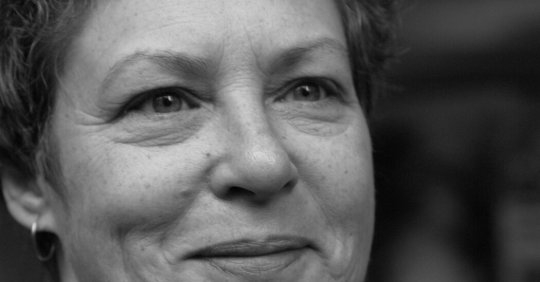
View On WordPress
0 notes
Photo
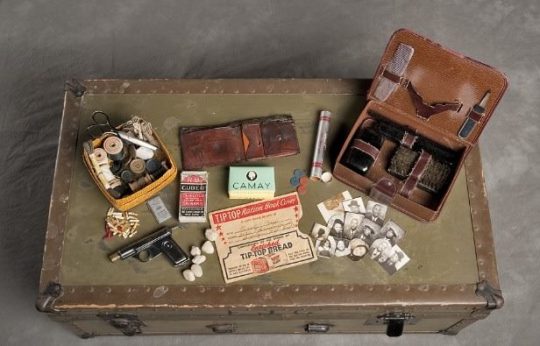



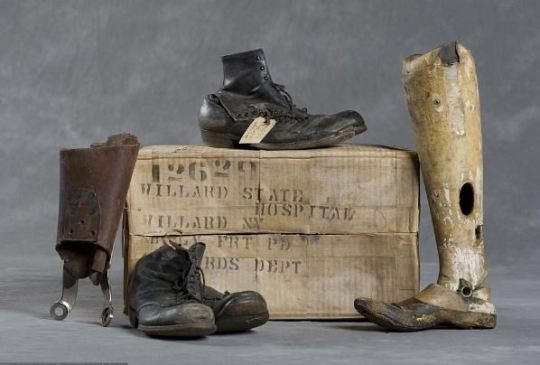


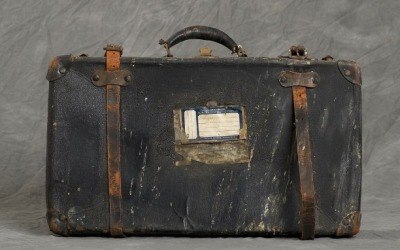

In 1995, Willard Psychiatric Center closed its doors, giving employee Bev Cartwright the task of sorting through more than 400 suitcases left behind by patients admitted between 1910 and 1960.
The scant belongings assembled together became works of art, revealing so much about their owners—or do they?
What might your possessions suggest about you when you're gone? Will they leave an accurate impression?
For more about the project, visit http://www.willardsuitcases.com/.
0 notes
Photo



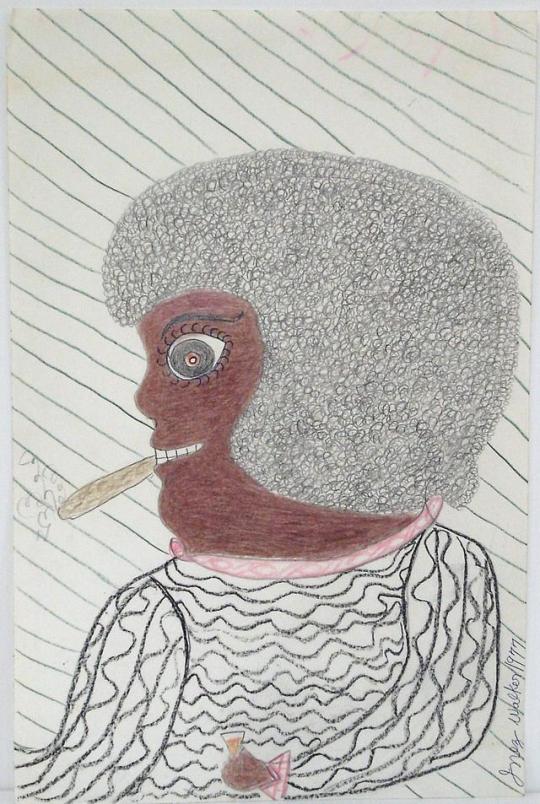

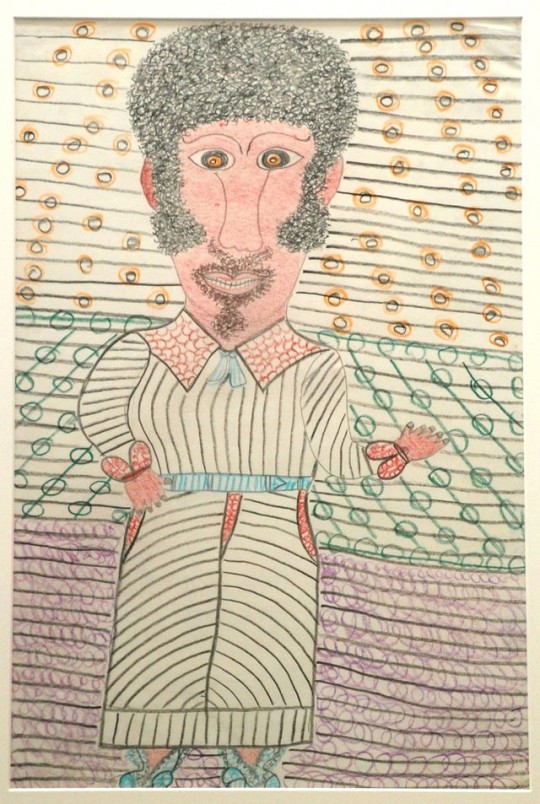
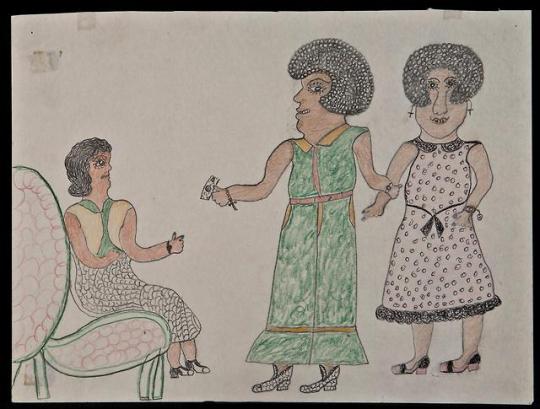

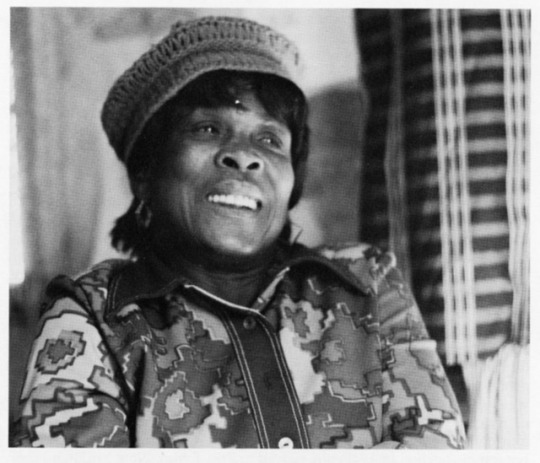
Inez Nathaniel Walker (1911–1990)
Born in Stedman, South Carolina, in 1911, Inez Nathaniel Walker joined the African American migration to the North in the 1930s. She eventually settled in rural New York, where she worked in an apple processing plant. Like many other self-taught artists, Walker turned to artmaking after a traumatic experience: she began to draw in the late 1960s or early 1970s while in prison for the manslaughter of an abusive male friend. To escape the loneliness and monotony of prison life, Walker drew numerous portraits of fashionably dressed and meticulously groomed men and women. After her release in 1972, Walker further developed her distinctive style, which is characterized by bold draftsmanship and inventive patterning.
“I just draw by my own mission, you know. I just sit down and start to drawing.” -- Inez Nathaniel Walker
Walker disappeared from society around 1980. Sadly, Pat Parson found her several years later, in the Willard Psychiatric Center in Willard, New York. Walker was in and out of the center for the last four years of her life, and died there in 1990. She left behind a collection of work remarkable in its size and consistency as well as in the remarkable manner in which the eyes engage the viewer. Clearly that is where the artist looked first to take the measure of a person.
8 notes
·
View notes
Text
“They were called crackheads and bad parents. They were forced to wear cones on their heads with humiliating signs. They shoveled snow with spoons, and stood stoically as drill instructors forced them to fill their pockets with wet food from the mess hall when they couldn’t eat it all. Sometimes they were hit or were sexually abused. Afterward, they were sent home from prison, ostensibly cured and no longer a threat to society.
In New York’s shock incarceration programs, prisoners with three years or less left on their sentences can spend six months doing drills, learning military discipline and taking substance abuse classes in a strict “therapeutic community” environment in exchange for an early shot at freedom.
Such programs are largely unknown to the public. But people in county jails and drug courts, and in prison reception centers and on the streets, are well acquainted with them.
The decades-old programs in the New York State Department of Corrections and Community Supervision (DOCCS) are some of the last in the country. The “tough love” programs claim a lower recidivism rate, and they have long been a darling of the tough-on-crime upstate Republican lawmakers who court corrections officer union support and tout the possibility of cost savings from early releases.
“The program works, it’s successful,” said Philip Palmesano, a member of the State Assembly whose district includes one facility that houses a shock-style program.
But interviews with more than a dozen former prisoners tell a different story. They told The Appeal that shock programs are “torture,” “hell,” and like “Guantánamo Bay.”
Some said they were forced to go off psychiatric medications to participate, and others recounted daily name-calling, humiliation, and physical abuse by corrections staff. Former prisoners interviewed—even those who said the program helped instill discipline and kickstart their sobriety—consistently offered similarly harrowing stories about their treatment.
Claims of abuse at the controversial programs aren’t new, though the facilities housing them rarely make the news unless a prisoner dies or an officer is arrested for abuse or misconduct. In recent years, staff there have been accused of raping prisoners, forging papers, falsifying time cards, and having an inappropriate relationship with a prisoner.
“While these programs are strict and rigorous, the Department has zero tolerance for any incident of harassment or assault, claims of which are vigorously investigated,” DOCCS spokesman Thomas Mailey told The Appeal.
In other states, now-defunct programs faced similar allegations of abuse, along with mounting evidence that they are ineffective at rehabilitating people who commit crime. In New York, state officials closed two of the facilities. Three such facilities remain: Lakeview Shock Incarceration near Lake Erie; Moriah Shock Incarceration near the Vermont border; and Willard Drug Treatment, a 90-day version of the program geared toward parole violators. All told, the programs currently hold roughly 1,200 prisoners, with capacity for about 1,800.
They are some of the last in the country.
Shock roots in drug war escalation
New York’s first shock incarceration program launched in 1987. The war on drugs was ramping up, thanks to high-profile tragedies like the June 1986 death of 22-year-old University of Maryland basketball star Len Bias, who collapsed in his dorm room and then succumbed to a heart attack triggered by “cocaine intoxication.” Eric Sterling, assistant counsel to the U.S. House Judiciary Committee from 1979 until 1989, later called Bias’s death the “9/11 of athletics.” Criminal justice policy then underwent a shift from more rehabilitative approaches to more punitive ones. Paramilitary-style programs fit the new mold.
Typically, the programs promised to reduce recidivism and prison overcrowding, but they also appealed to America’s tough-on-crime ethos. Symbolically, their military sensibilities meshed well with the war on drugs analogies, as criminologists Faith Lutze and Jenny Lau detailed in anexamination of the facilities published in 2017.
Politically, shock programs provided powerful images of reform. Shock prisoners wear ties or bow ties and parade around campus with buzzed heads and shiny boots. They make neat beds, stand at attention, and move in formation.
Initially, shock programs focused almost exclusively on military discipline. But later a second wave of shock incarceration added education, treatment, and life skills. More recent iterations involve increased attention to aftercare to help with re-entry.
By the mid-1990s, there were at least 65 programs inspired by military boot camps nationwide, according to Lutze and Lau. The Federal Bureau of Prisons opened some as did states and counties from Texas to Florida. The sentence-reducing alternatives were particularly attractive at a time when many states were under court orders to crack down on prison overcrowding.
At one point, New York boasted five military-style boot camp programs. Four were dubbed “shock” facilities and the fifth, Willard, was called a drug treatment campus. But all relied on the harsh discipline, military methods, and therapeutic community approach typically associated with shock incarceration.
Thanks to the promise of early release, shock didn’t just free up prison space; state officials said it also saved taxpayer money. In 2015, DOCCS officials said shock saved the state nearly $1.5 billion in incarceration costs since its inception in the late 1980s. Initially New York only included men under 23 in the programs, but over time the offerings expanded to include women (at least at Lakeview and Willard) and the age limit was raised to 50.
By 2000, there were 95 boot camp programs across the country. But the initial proliferation outpaced research about them and, amid growing concerns about their efficacy and a string of deaths and lawsuits, the programs began falling out of favor. Now, the number of such programs appears to be in decline, although there hasn’t really been a full accounting of them in nearly two decades.
Amid falling enrollment—possibly due to reforms that keep low-level drug offenders out of prison— New York made the move to shutter some of its shock facilities starting in 2011, sparking pushback in local communities and from the lawmakers representing them. Despite concerns from outside experts and researchers, the programs still have strong support among state legislators.
“I am a firm believer in shock,” Assemblymember Palmesano said. “It teaches discipline and respect and I think those are important things to teach those individuals who are in there.”
No other state lawmakers with shock programs in their districts responded to The Appeal’s requests for comment. The guards union, New York State Correctional Officers & Police Benevolent Association, initially responded to an email but ultimately did not provide comment. Prison officials declined interview requests.
Heavily restricted rights
For new prisoners, the abuse begins on the bus.
Shackled and handcuffed, fresh recruits arrive every week, sometimes shipped from other prisons after years behind bars, other times sent in straight out of intake.
“When you get in on that bus they come in screaming at you, slapping you,” said one man who graduated from Lakeview Shock Incarceration last year. Like many of the former prisoners interviewed by The Appeal, he asked to remain anonymous because he is still on parole and fears retaliation from parole officials.
“They’ll put their hands on you,” he said. “And there’s nothing you can do about it. They don’t care.”
Screaming is part of the daily routine. It starts before dawn. Sometime around 5:30 a.m., as soon as the lights are turned on, prisoners are expected to leap out of their bunks shouting. Then they have three minutes to get dressed before heading outside for group exercise, where they run in 90-degree summer heat or do push-ups in the winter snow.
“They’ll scream in your face and call you all types of names and belittle and intimidate you as much as they can to get a reaction,” the former Lakeview prisoner said. “I’ve seen people give it back to them—just being a smartass—and get handcuffed and sent to SHU [Special Housing Unit, or solitary confinement].”
When they come inside for breakfast, they march in a military-style parade line. Prisoners can take as much food as they want, but if they don’t clear their trays in the allotted time—typically five to eight minutes at the most, according to former prisoners—they risk humiliating consequences.
“You’d have to eat everything or they’d make you carry it with you in your pockets,” said Samantha, who was in the program at Willard seven years ago, and asked to be identified only by her first name.
Sometimes, in retribution for alleged infractions committed earlier in the day, drill instructors make prisoners kneel on the mess hall seats, stand to eat, or make the whole platoon squat.
The daytime hours include programs like GED or vocational training, or work assignments. On “confrontation days” in substance abuse classes, one prisoner sits in the center of the room in a military position and is forbidden to respond or react as others aggressively confront negative behavior, according to multiple program graduates.
In their limited free time, shock attendees can shine their boots, write letters, iron their clothes and make their bunks. Shock alums said that except when they are in school or drug treatment, prisoners are not allowed to sit down without permission. Until recently, both male and female prisoners had their heads shaved upon arrival, though at Willard that is no longer required for women, a DOCCS spokesperson said.
The few perks that exist in regular prison are generally not permitted in shock: There’s no TV, books are largely restricted to self-help, commissary buys are limited, packages are not allowed, and prisoners only get one phone call home every other week.
And then there are the punishments, or “learning experiences.” Most commonly, prisoners are made to carry around logs for days at a time. But in some cases former prisoners recalled more humiliating punishments. Some said they had been made to stand and stare at a flagpole for hours, while others said they had been forced to wear embarrassing signs and sashes around the facility.
In one instance, a woman recounted watching another prisoner run around a bush in circles as drill instructors threw shoes at her, a punishment meted out after she was caught staring at the men across the yard.
One former Lakeview employee, who asked not to be named because she still works for the state government, said such punishments were common.
“There was a lot of humiliation and embarrassment and I know that’s part of boot camp,” she told The Appeal. “But I think there’s a difference between training someone to kill and training someone to succeed after being behind bars.”
In some cases, degrading treatment wasn’t even in response to a specific misdeed. Cathy—who did the programs at both Lakeview and Willard and asked that her last name not be used—recounted being called “disgusting” and a “water buffalo” because of her size. She said that once after she asked for permission to speak, a drill instructor told her: “You don’t need my permission, you ate my words.”
Other program graduates and participants offered similar details about routine name-calling and degrading comments ranging from drill instructors insulting their mothers to being called crackheads, as well as inconsistent treatment. “It’s like being in an abusive relationship,” said Marge, who completed shock in 2012, and asked to be identified only by her first name. “You never know what’s going to happen next.”
A shock success
Coss Marte is one of the program’s shining success stories.
The Manhattan native started selling drugs in the late 1990s as a teen on the Lower East Side, then a neighborhood where illicit narcotics were plentiful and crime was frequent. At first, he said he hustled outside a corner store, but later he turned to large-scale sales, and pulled in millions. Marte’s run on the streets ended in the criminal legal system.
In 2006, he did shock for the first time at the the now-shuttered Monterey boot camp. After completing the program, Marte caught another charge and went back to prison, where he went through the boot camp two more times.
But after his release from Lakeview in 2013, Marte launched ConBody, a Manhattan gym featuring prison-inspired workouts like those he learned in shock. Currently, he manages dozens of clients, with multiple classes a week and a stable of trainers, many of whom are formerly incarcerated, working for him.
In some ways, Marte said, shock helped him.
“I definitely liked the discipline factor,” he said. “You wake up, you work out, you make your bed and you get into the routine of doing day-to-day what you should be doing out in the streets.”
But Marte said Alcohol and Substance Abuse Treatment, the six-month drug treatment program commonly referred to as ASAT, is “pretty much bullshit.” His substance use history consisted of smoking marijuana daily and he said that many of his fellow shock prisoners didn’t have significant substance use histories, either. And Marte said that although he appreciated the shock regimen as well as the discipline the program instilled in him, it was also highly abusive.
On a near-daily basis, Marte said, he watched the guards hit male prisoners. Then Marte himself got hit and thrown into “the box”—solitary confinement—in retribution for allegedly putting up a fight.
That outcome wasn’t unusual, Marte said. Claims of prison abuse are notoriously hard to corroborate, given the secrecy of prison administrations, the scarcity of releasable video footage and limited outside oversight. But several prisoners told The Appeal that they witnessed similar abuse, as did the former Lakeview staffer who expressed concerns about prisoner treatment.
During an incident in 2018, the ex-employee said she watched a drill instructor punch a prisoner three times because he rolled his eyes. Three other current and former employees who spoke with The Appeal did not recount seeing such treatment, but two said they were not in stationed in an area where they would have been likely to witness it, and the third said she had only heard rumors about abuse.
In some cases, prisoners may file grievances—a legally required first step before filing a lawsuit—but many said they were scared to do so because they feared being kicked out of the program.
“You just didn’t, you knew that you couldn’t,” said Samantha, the former Willard prisoner. Samantha said she once complained to officials about mistreatment but later worried for her physical safety after prison staff pulled her into another room and pretended to shoot her.
“The only thing going through my mind was, ‘Are they going to take us out to an abandoned building and like, I don’t know, kill us?’” she said.
In 2013, one woman told the Albany Times-Union that a guard raped her at Lakeview.
When another prisoner informed authorities about the alleged assault, she was tossed in solitary for four days.
‘You can’t treat mental illness by beating it out of people’
Critics say that the premise of boot camp incarceration—using military basic training-style discipline to rehabilitate prisoners—is flawed.
“The reason boot camps were started,” said Christine Tartaro, a criminal justice professor at Stockton University in New Jersey, “is because we all heard of somebody who was a screw-up and went to the military and it worked out.”
But military boot camp graduates finish basic training with the guarantee of a job, housing, pension, healthcare, and food. And their post-boot camp career prospects are likely to be bright.
“Released inmates have none of those things,” Tartaro said. And even the military has made efforts to curb abusive techniques associated with basic training.
Ojmarrh Mitchell, a University of South Florida associate professor who has extensively studied shock incarceration, says there’s no empirical evidence supporting the programs’ effectiveness for rehabilitation.
“They’re problematic in a number of ways,” he said. “It’s not just the abuse that goes on but another big problem is that they don’t deter crime. They were touted as these programs that would lead to reductions in crime because they’re so onerous that they would basically scare inmates straight.”
Research shows that shock programs do not significantly reduce recidivism. Some prisoners report positive shock experiences just because the programs are less boring than regular prison, Mitchell said. And, typically, there’s less prisoner-on-prisoner violence and some positive prosocial change, even though researchers Lutze and Lau noted that shock prisoners report more feelings of conflict, helplessness, and isolation.
“The bottom line is when you have people with addiction, there’s an enormous amount of mental illness in this population,” said Maia Szalavitz, a journalist who examined boot camp incarceration in her 2006 book “Help at Any Cost.” “Screaming at them, hitting them, doing all these things to break them down is traumatizing.”
She also criticized shock programs for refusing to give prisoners medication-assisted treatment, such as methadone or suboxone.
“The idea that we’re treating addiction in places that refuse the standard of care is ludicrous,” she said, adding that there is “no data” suggesting boot camp programs are helpful in treating substance use disorder.
“You can’t treat mental illness by beating it out of people,” she said. “Depression doesn’t get cured by forced marches.”
Aside from the questionable treatment approaches, multiple experts told The Appeal that shock programs are a breeding ground for abusive treatment. While one of the former workers who spoke to The Appeal framed “abuse” as a subjective term, another said the culture that fostered such treatment was so problematic that “no amount of pay or benefits or anything” was worth it.
“I remember coming home in tears one night,” the worker said, “and telling my husband six months from now, I could really think and act like these people and I don’t want that to be me.”
A few weeks later, she quit.
- Keri Blakinger, “NEW YORK PRISONS OFFER ‘TOUGH LOVE’ BOOT CAMP PROGRAMS. BUT PRISONERS SAY THEY’RE ‘TORTURE’ AND ‘HELL.’” The Appeal, May 21, 2019.
#new york#new york state department of corrections and community supervision#boot camp#shock incarceration#high impact incarceration program#disciplinary society#military discipline#prison discipline#the prison and the factory#prison boot camp#discipline and punish#the new penology#militarized citizenry#crime and punishment#drug treatment in prison#treatment programs in prison
0 notes
Link
In 1995, the New York State Office of Mental Health closed the Willard Psychiatric Center in Willard, NY. It would eventually become a state-run drug rehabilitation center for prisoners. A Willard employee, Bev Courtwright, was given the task of going through all of the psych center buildings to determine what should be salvaged. She unlocked an attic door behind which was a collection of over 400 suitcases containing the possessions of former patients. The cases had been put into storage when their owners were admitted to Willard sometime between 1910 and 1960. And since the facility was set up to help people with chronic mental illness, most of these folks never left, and many were buried in the cemetery across the road.
Craig Williams acquired the cases for the New York State Museum and they were placed in the permanent collection. I first saw them in 2003 at an exhibit in the Museum where a small number of the suitcases were displayed. It was very moving to read the stories of these people, and to see objects from their lives before they became residents of Willard, and I was determined to photograph more of these cases so others could experience what I felt.
In 2011, the Museum gave me the incredible opportunity to begin this project. These objects open a small window into the lives of some of the people who lived at the facility, and I am determined to share them with as many people as possible. You can see the genesis of my approach to this documentation on my wordpress site, here and here. If you would like to watch the Kickstarter video, click here.
The second Kickstarter is now up. Check it out here.
– Jon Crispin
If you haven’t seen this, you need to see this
0 notes
Text
The destruction of America
Stuff Nobody Cares AboutA not so random collection of observations about things you should care about, but no one does because History no longer plays a part in America 45 Communist Goals For America In 1963 – How Many Have Come True?The 1963 Congressional Record Lists 45 Goals For Communism To Achieve In America.Decide For Yourself How Many Have Become Reality.The Calm Good Old Days of May Day – May 1, 1937 – A man holding an American flag attends a peaceful May Day assembly at Union Square in New York City. credit photo: AcmeToday is May Day.How May 1 mutated from a day of championing workers rights into a day of promoting socialism, communism, and all perceived injustices does not concern the average person on the street. Yet, it is a fact that there is more division, discord and disgruntlement in America as ever before.How did we arrive at this point in history?If you were to say there is a concerted effort to undermine democracy in the United States, you may be called a conspiracy theory nut or a supporter of President Donald Trump or his predecessor, President Barrack Obama. It’s kind of funny how both Democrats and Republicans see the other party as eradicators of freedom.But what is behind it all? Communism? Please, don’t be ridiculous. After all, Senator Joe McCarthy and the House of Un-American Activities Committee was all just a witch hunt persecuting the innocent. Were there ever any communists in high places or influencing mass media? Did communists have any goals they wanted to bring about in America?Though the following story has been regurgitated around the internet for a number of years, we investigated the veracity of the following claim:In 1963 Florida (Democratic) Congressman Albert “Syd” Herlong read into the Congressional Record, “45 Goals of Communists” to bring about in the United States. One of Herlong’s constituents, Mrs. Patricia Nordman provided the list which came from a book by Willard Cleon Skousen, The Naked Communist,(1958).It is always said, “consider the source.” We’ll briefly examine the source, Skousen, following his 45 goals list.Simply put, it is true. The “45 Goals of Communists” was entered into the Congressional Record in 1963. And Skousen did write The Naked Communist.The focus of the book was the communist country of strength at the time, the U.S.S.R. (Russia). Regardless of alleged U.S. election meddling, today China is the dominant and more dangerous communist force in the world.How many of these goals have come to fruition?Communist Goals (1963) Congressional Record–Appendix, pp. A34-A35, January 10, 1963Current Communist GoalsEXTENSION OF REMARKS OF HON. A. S. HERLONG, JR. OF FLORIDA IN THE HOUSE OF REPRESENTATIVES Thursday, January 10, 1963 .Mr. HERLONG: Mr. Speaker, Mrs. Patricia Nordman of De Land, Fla., is an ardent and articulate opponent of communism, and until recently published the De Land Courier, which she dedicated to the purpose of alerting the public to the dangers of communism in America.At Mrs. Nordman’s request, I include in the RECORD, under unanimous consent, the following “Current Communist Goals,” which she identifies as an excerpt from “The Naked Communist,” by Cleon Skousen:[From “The Naked Communist,” by Cleon Skousen]Current Communist Goals1. U.S. acceptance of coexistence as the only alternative to atomic war.2. U.S. willingness to capitulate in preference to engaging in atomic war.3. Develop the illusion that total disarmament [by] the United States would be a demonstration of moral strength.4. Permit free trade between all nations regardless of Communist affiliation and regardless of whether or not items could be used for war.5. Extension of long-term loans to Russia and Soviet satellites.6. Provide American aid to all nations regardless of Communist domination.7. Grant recognition of Red China. Admission of Red China to the U.N.8. Set up East and West Germany as separate states in spite of Khrushchev’s promise in 1955 to settle the German question by free elections under supervision of the U.N.9. Prolong the conferences to ban atomic tests because the United States has agreed to suspend tests as long as negotiations are in progress.10. Allow all Soviet satellites individual representation in the U.N.11. Promote the U.N. as the only hope for mankind. If its charter is rewritten, demand that it be set up as a one-world government with its own independent armed forces. (Some Communist leaders believe the world can be taken over as easily by the U.N. as by Moscow. Sometimes these two centers compete with each other as they are now doing in the Congo.)12. Resist any attempt to outlaw the Communist Party.13. Do away with all loyalty oaths.14. Continue giving Russia access to the U.S. Patent Office.15. Capture one or both of the political parties in the United States.16. Use technical decisions of the courts to weaken basic American institutions by claiming their activities violate civil rights.17. Get control of the schools. Use them as transmission belts for socialism and current Communist propaganda. Soften the curriculum. Get control of teachers’ associations. Put the party line in textbooks.18. Gain control of all student newspapers.19. Use student riots to foment public protests against programs or organizations which are under Communist attack.20. Infiltrate the press. Get control of book-review assignments, editorial writing, policy-making positions.21. Gain control of key positions in radio, TV, and motion pictures.22. Continue discrediting American culture by degrading all forms of artistic expression. An American Communist cell was told to “eliminate all good sculpture from parks and buildings, substitute shapeless, awkward and meaningless forms.”23. Control art critics and directors of art museums. “Our plan is to promote ugliness, repulsive, meaningless art.”24. Eliminate all laws governing obscenity by calling them “censorship” and a violation of free speech and free press.25. Break down cultural standards of morality by promoting pornography and obscenity in books, magazines, motion pictures, radio, and TV.26. Present homosexuality, degeneracy and promiscuity as “normal, natural, healthy.”27. Infiltrate the churches and replace revealed religion with “social” religion. Discredit the Bible and emphasize the need for intellectual maturity, which does not need a “religious crutch.”28. Eliminate prayer or any phase of religious expression in the schools on the ground that it violates the principle of “separation of church and state.”29. Discredit the American Constitution by calling it inadequate, old-fashioned, out of step with modern needs, a hindrance to cooperation between nations on a worldwide basis.30. Discredit the American Founding Fathers. Present them as selfish aristocrats who had no concern for the “common man.”31. Belittle all forms of American culture and discourage the teaching of American history on the ground that it was only a minor part of the “big picture.” Give more emphasis to Russian history since the Communists took over.32. Support any socialist movement to give centralized control over any part of the culture–education, social agencies, welfare programs, mental health clinics, etc.33. Eliminate all laws or procedures which interfere with the operation of the Communist apparatus.34. Eliminate the House Committee on Un-American Activities.35. Discredit and eventually dismantle the FBI.36. Infiltrate and gain control of more unions.37. Infiltrate and gain control of big business.38. Transfer some of the powers of arrest from the police to social agencies. Treat all behavioral problems as psychiatric disorders which no one but psychiatrists can understand [or treat].39. Dominate the psychiatric profession and use mental health laws as a means of gaining coercive control over those who oppose Communist goals.40. Discredit the family as an institution. Encourage promiscuity and easy divorce.41. Emphasize the need to raise children away from the negative influence of parents. Attribute prejudices, mental blocks and retarding of children to suppressive influence of parents.42. Create the impression that violence and insurrection are legitimate aspects of the American tradition; that students and special-interest groups should rise up and use [“]united force[“] to solve economic, political or social problems.43. Overthrow all colonial governments before native populations are ready for self-government.44. Internationalize the Panama Canal.45. Repeal the Connally reservation so the United States cannot prevent the World Court from seizing jurisdiction [over domestic problems. Give the World Court jurisdiction] over nations and individuals alike.Realize first that Congressmen can enter anything into the Congressional Record. So this was not a big speech that enraptured Congress. Skousen’s work being cited word for word in the Congressional Record is not that unusual. What is unusual is that somebody found this text was in the Record and started to spread it on the internet. From that point on it has been used by conservative groups to show the inroads communism has made in the United States over the last five decades.Skousen (1913-2006) during his long life was an FBI Special Agent; an attorney; a teacher at Brigham Young University; author and a Mormon theolgan. He was also most notably a fervent opponent of communism and promoter of the free market.According to his many detractors he was a charlatan with zany beliefs including that the Founding Fathers were direct descendants of the Lost Tribes of Israel, who had migrated to the British Isles—and that by extension, the Constitution was the direct descendant of the ruling system of the ancient Israelites. There is absolutely no truth in that.In 1960 Skousen was fired as Chief of Police in Salt Lake City by Mayor J. Bracken Lee. After the firing Lee wrote that Skousen “is a very dangerous man because he preaches one thing, practices another, does not tell the truth, and cannot be relied upon. He also was one of the greatest spenders of public funds of anyone who ever served in any capacity in Salt Lake City government.”Critics have attacked Skousen’s affiliation with the ultra-conservative John Birch Society (he was never a member) along with his behavior, creationist beliefs, etc.. He was accused as a self-promoter who inflated his own accomplishments.While Skousen may be unsavory, instead of examining and debating the cited text of The Naked Communist, the man has been sullied.To discredit the 45 goals, it was pointed out one of Skousen’s sources, Arsene De Goulevitch used Boris Brasol as one of his sources.Brasol, was a czarist emigre to the Unites States who helped to spread “The Protocols of the Elders of Zion,” a forged anti-Semitic diatribe that continues to influence the ignorant.The germane question is: does all of that negate that these were and are actually communist goals?Skousen writes of the 45 goals:If the student will read the reports of Congressional hearings together with available books by ex-Communists, he will find all of these Communist objectives described in detail. Furthermore, he will come to understand how many well-meaning citizens have become involved in pushing forward the Communist program without realizing it. They became converted to Communist objectives because they accepted superficial Communist slogans. Soon they were thinking precisely the way the Communists wanted them to think.Here you can read the entire text of The Naked Communist and see if it makes any sense to you. Skousen may come off as a paranoid loony. Or he may have been exposing an actual plan to infiltrate America.Decide for yourself if the arguments presented are nonsense or if in the past 56 years we are being transformed into disciples and prisoners of communism.“Be seeing you.”
0 notes
Photo

Yiddish Book Center Virtual Talk Hi Everyone. I am not posting here on Wordpress so much as I mostly am doing…
#@willardsuitcases#Ilan Stavans#Jon Crispin#Mental Health#Mental Health Awareness#Willard Asylum#Willard Asylum Suitcases#Willard Psychiatric Center#Willard Suitcase Project#willard suitcases#Willard Suitcases Project#Yiddish Book Center
1 note
·
View note
Text
When a reader recently emailed me suggesting I update my Willard posts to correct the name of the Willard grave-digger and patient from “Lawrence Marek” to his actual given name Lawrence Mocha. I was happy to make that correction, even happier to learn that Lawrence Mocha will most likely be properly memorialized in the cemetery to he so meticulously took care of during his time as a resident at Willard State hospital.
Patient Identification
Special thanks to Darby Penney and Suitcases from a State Hospital Attic for allowing me use of this image.
Lawrence Mocha had been identified a few various different ways over the course time because of Privacy Laws:
When he entered Willard State Hospital he became patient #14956.
When he was laid to rest at Willard Graveyard there was no marker bearing his name, he was assigned yet another number.
Later when the Willard Suitcases were discovered in an attic Mocha was given the pseudonym Marek for the book The Lives They Left Behind: Suitcases from a State Hospital Attic to adhere to health care privacy laws.
After years of work the Willard Cemetery Memorial Committee, with the help of John Allen of the Office of Mental Health, has made contact with a relative of Lawrence Mocha and the family has given their consent to proceed with a memorial, finally publicly identifying and honoring Lawrence Mocha by his given name. This Finger Lakes Times article discusses the group effort that was involved in tracking down relatives and the future memorialization at the cemetery.
Skimming through my posts to make the name corrections, I realized I had only written one paragraph about Mr. Mocha, for the sake of brevity in an already long-winded series of posts, even though I had done quite a bit of research on the turn of events that brought Mr. Mocha to Willard State Hospital in Romulus NY.
Mr. Mocha’s story is moving, and it deserves more than a single paragraph.
Lawrence Mocha
Mr. Mocha was born into a poor family in Austro-Hungarian Galicia (now known as Austria) in 1878. It seems Mr. Mocha’s problems began with a head injury he suffered as a young man, when he was hit in the head with a rock at the age of 27. After the head injury, Mr. Mocha is said to have started drinking heavily. It was during this time Mr. Mocha was first hospitalized for a brief period of time in Düsseldorf.
Once released Mocha served in the Army, he then emigrated to America around 1907. Mocha found work in New York City washing windows at Bellevue Hospital and took night classes to learn English.
Bellevue Hospital, 28th St., New York City.
In 1916 Mocha caused quite a stir by being “loud, boisterous, singing, shouting, praying, claiming to hear the voice of God.” and was sent to the psychiatric unit where he talked of guilt and depression, of hearing God and seeing angels.
Mocha was transferred to Willard State Hospital in 1918, at only 40 years old he would be considered a ward of the hospital for the rest of his life. Mr. Mocha was said to of kept to himself for a few years at Willard State Hospital but eventually he showed an interest in doing some grounds maintenance work, and began tending the graveyard where deceased patients of the psychiatric hospital were laid to rest, digging precise burial sites by hand using a pick and shovel.
Mocha’s Request
In 1945, after 27 years of year-round labor at the state hospital, at the age of 67 Mr. Mocha with no one else to advocate for him, penned a letter to the hospital superintendent of Willard, requesting his release.
Special thanks to Darby Penney and Suitcases from a State Hospital Attic for allowing me use of this image.
The letter reads:
October 19, 1945
Dr. Keill,
I hereby Lawrence Mocha stop work. Yesterday afternoon, I ask you Dr. to discharged me from Willard Institution. I am capable to do my living independently I want also to get money for my work here, I make over eight years more than five hundred graves myself another heavy work all year around. I asked Dr. to prepare my trunk, which I brought here from Central Islip it is my own I bought it in Düsseldorf.
I am Respectfully yours,
*I think it is important to note there are likely language misinterpretations and grammatical errors related to English not being Mr. Mocha’s primary language.
I don’t think I have ever read such a sad letter. After being institutionalized for so long, Mocha was confident in his mental state, and hopeful to build a life for himself outside of the hospital.
Unfortunately, standard psychiatric treatment at the time was focused on long-term institutionalization rather than treatment and reintegration into society and Mr. Mocha’s request for discharge fell on deaf ears. He silently continued his work as an unpaid gravedigger for Willard, for 23 more years, despite the fact he never had any more “episodes”.
A sense of purpose
It seems Mocha eventually came to terms with his institutionalization and found a sense of purpose in his work. He even built himself a simple wooden shack in the graveyard, where he stayed during the warmer months of the year.
The last grounds superintendent at Willard, Gunter Minges remembers Mr. Mocha as “A reclusive man, who had special kitchen privileges, smoked a pipe, and wore hip waders, because groundwater would fill his neat rectangular holes while he was digging”.
Gunter Minges also said “He dug until he died”
In 1968, at the age of 90 Mr. Mocha was laid to rest in a numbered grave in the same grounds he took care of for years.
Willard cemetary today
Resources:
A couple of images used in the post are courtesy of Darby Penney, and can be found along with stories from other Willard patients in the book The Lives They Left Behind: Suitcases from a State Hospital Attic, make sure to check this book out and ‘Like’ their Facebook Page, Suitcases from a State Hospital Attic .
The Willard Memorial Cemetary Project
The Lives They Left Behind: Suitcases from a State Hospital Attic, by Darby Penney (Author), Peter Stastny (Author) & Lisa Rinzler (Photographer)
The Inmates of Willard 1870 to 1900 / A Genealogy Resource
Mocha, others buried at Willard may get honored, written by David Shaw for The Finger Lakes Times
Restoring Lost Names, Recapturing Lost Dignity, written by Dan Barry for the New York Times
Sad Lives Openly on Display, written by Craig Wilson for USA Today
Lawrence Mocha: The Willard Grave Digger When a reader recently emailed me suggesting I update my Willard posts to correct the name of the Willard grave-digger and patient from "Lawrence Marek" to his actual given name Lawrence Mocha.
0 notes
Text
Snaps of the Past...
Asylum Suitcases, Found And Photographed
by CLAIRE O'NEILL, NPR.org
March 04, 2013 1:58 PM
full article here
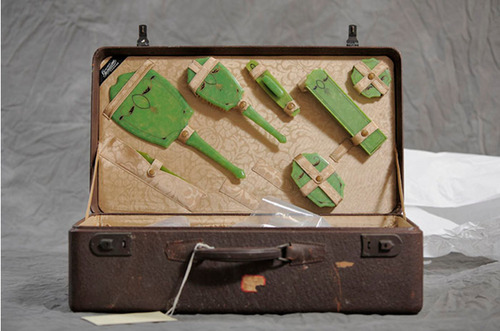
Crispin's latest fascination is with old suitcases — discovered by the New York State Museum in an attic of the Willard Psychiatric Center in Willard, N.Y. "The cases were put into storage when their owners were admitted to Willard sometime between 1910 and the 1960s," Crispin explains on a Kickstarter page, where he is raising funds to continue photographing. "And since the facility was set up to help people with chronic mental illness, these folks never left."
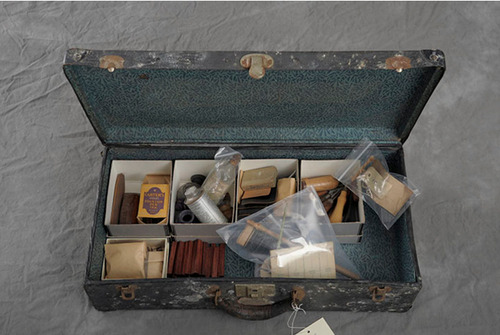
There are about 400 suitcases in the collection, many of them empty. The contents in the suitcases — and the suitcases themselves — have been wrapped in archival paper by the museum. Crispin's stylistic approach is to photograph the wrapping, the exterior, the interior and finally details of the contents.
"I try to make them look as beautiful as they are," he says. "And they're touching too. My goal as a photographer is to have people react." The suitcases contain letters that were never mailed, diaphanous cigarette papers, a glass bottle of glycerin left behind by a craftswoman — tiny parts of a forgotten whole.
"I am so interested in these cases," Crispin writes. "And I am totally wigged out by being able to photograph a representation of the lives of people who struggled so much to make it in a very stressful and confusing world." You can follow the suitcase documentary project on his blog, where he muses in real time with each photograph.


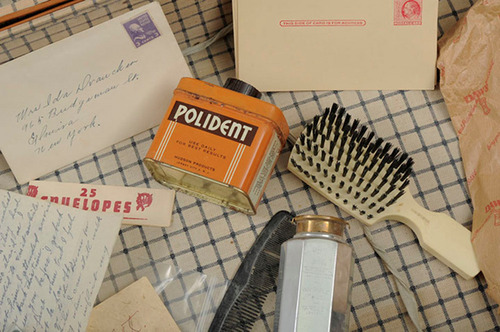
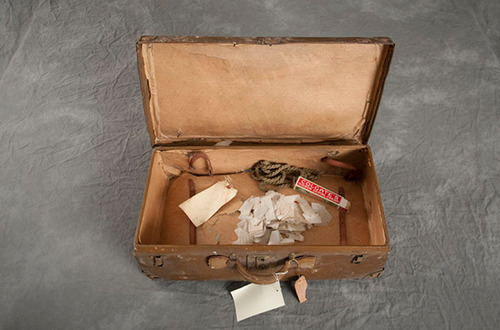
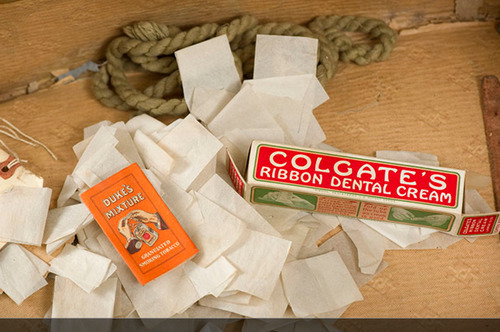


1 note
·
View note
Text
On the Radio
Hi Friends. Sorry for the late notice but I will be on WXXI Rochester today (6 April) at 1:00 PM. (wxxinews.org) I will be talking about the suitcases and will be joined by the amazing Peg Ellsworth who worked at Willard for almost 40 years. The program will also be archived so you can listen later. Thanks!

View On WordPress
#Jon Crispin#Willard Asylum#Willard Asylum Suitcases#Willard Psychiatric Center#Willard Suitcase Project#willard suitcases#Willard Suitcases Project#wxxinews
1 note
·
View note
Link
When Willard Psychiatric Center in New York's Finger Lakes closed in 1995, workers discovered hundreds of suitcases in the attic of an abandoned building. Many of them appeared untouched since their owners packed them decades earlier before entering the institution. http://www.suitcaseexhibit.org/indexhasflash.html
0 notes
Link
Jon Crispin is a photographer that spent part of the 1980s documenting abandoned asylums across New York state. He recently started a new project documenting suitcases that were found in the attic of the former Willard Psychiatric Center. These suitcases belonged to patients who were admitted between 1910 and 1960, because this was a chronic mental illness hospital, most of these people never left and didn't claim their belongings. Crispin documents the remnants of the suitcases that were saved by the New York State Museum.
It's an ongoing project and only a few have been documented so far, but it's interesting to see what people brought with them to the hospital.
-Kenda
10 notes
·
View notes